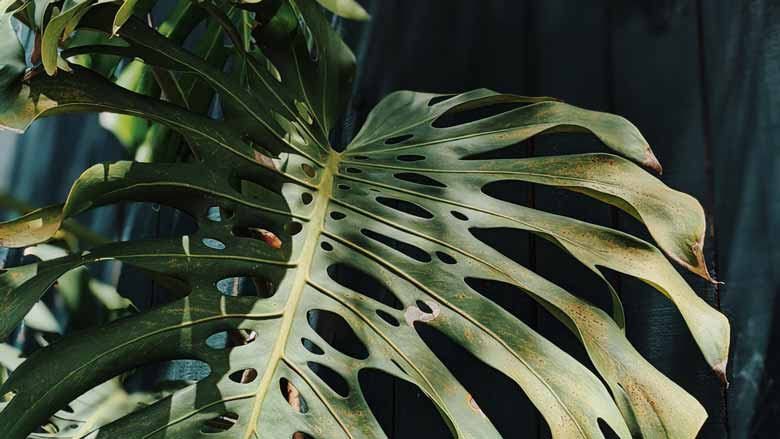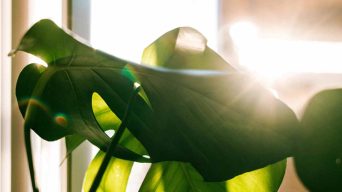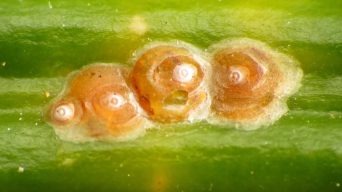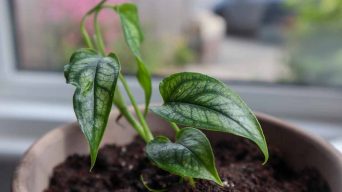Monstera plants are gorgeous, easy-to-care-for houseplants that can brighten up any space.
But sometimes, even the most well-cared-for Monsteras can get brown spots on their leaves.
Don’t worry, though – in most cases, these brown spots are harmless and can be easily treated!
Here’s everything you need to know about treating brown spots on Monstera leaves.
What Causes Brown Spots on Monstera Leaves and How To Treat Them
The Monstera plant is a popular indoor plant known for its large, beautiful leaves.
These leaves can grow up to three feet long and two feet wide!
However, sometimes Monstera plants can develop brown spots on their leaves.
There are a few different reasons why this may happen.
Below, we’ll discuss the most common causes of brown spots on Monstera leaves and how to treat them.
1. Too Much Sunlight
While Monstera plants are typically known for their ability to thrive in low-light conditions, too much sunlight can cause brown spots to form on the leaves.
The plant leaves are covered in a waxy substance that helps protect them from excessive moisture loss.
However, this waxy coating also makes the Monstera leaves susceptible to sunburn.
When exposed to direct sunlight for prolonged periods, the heat can cause the wax to break down, causing the leaves to dry out and eventually turn brown.
While a brown spot typically does not cause any lasting damage to the plant, it can be unsightly and may reduce its ability to photosynthesize effectively.
Treatment
If you think that too much sunlight is the cause of the brown spots on your Monstera’s leaves, the best course of action is to move the plant to a location that receives indirect or filtered light.
If possible, try to find a spot where the plant will receive morning sun and afternoon shade.
You may also want to consider using a sheer curtain or blind to filter the light and help prevent further sun damage.
If the damage is severe, you may need to cut off any affected leaves.
However, be sure to wait until the plant has had a chance to acclimate to its new location before doing so.
A damaged leaf will not recover, but the plant will eventually produce new leaves that are not affected.
To prevent sun damage in the future, ensure that your Monstera receives indirect or filtered light and is not exposed to direct sunlight for more than a few hours each day.
2. Watering Problems
Under or overwatering your Monstera plant can also cause brown spots to form on the leaves.
These plants are native to tropical rainforests, so they like to be kept in moist conditions.
Allowing the Monstera plant’s soil to dry out excessively can lead to browning and wilting of its leaves due to insufficient watering.
On the other hand, overwatering can also cause problems. If the soil is too wet, it can start to break down and compact, making it difficult for the roots to get the oxygen they need.
This can lead to rotting roots, which can cause the leaves to turn brown and eventually drop off.
Brown spots can also develop when Monstera plants are watered with hard water, as the minerals in the water can build up on the leaves and cause them to discolor.
Treatment
If you think that your plant is not being watered properly, you first need to take a close look at the soil.
Monstera plants like to have moist but not soggy soil.
The best way to tell if your plant needs water is to stick your finger into the soil.
If the soil is dry up to your first knuckle, it’s time to water the plant.
If the soil is wet or mushy, wait a few days before watering again.
It’s also essential to ensure that you are using the proper type of water for your plant.
Monstera plants prefer distilled or rainwater, as these types of water do not contain the minerals that can build up on the leaves and cause brown spots.
If you are using tap water, try letting it sit out overnight to allow the chlorine to evaporate before watering your plant.
3. Low Humidity
The Monstera is a tropical plant, so it prefers high humidity levels.
Monstera plants require high humidity to thrive, and they will often start to experience problems when the humidity drops below 40%.
One of the most common symptoms of low humidity is brown spots on the leaves.
These spots are caused by water vapor condensing on the leaves and then evaporating, damaging cell membranes.
Low humidity can also cause the leaves to become dry and brittle, and eventually, the tips of the leaves may turn brown.
Brown tips on Monstera leaves are typically a sign of low humidity.
Treatment
If you think that low humidity is the cause of the brown spots on your Monstera’s leaves, there are a few things you can do to raise the humidity around the plant.
One of the easiest ways to do this is to place the plant on a pebble tray.
A pebble tray is a shallow tray filled with pebbles and water.
The water evaporates and rises, providing the plant with the extra humidity it needs.
You can also use a humidifier to raise the humidity around your plant.
Just keep it away from the leaves to prevent them from getting too wet.
4. Temperature Extremes
Monstera plants are also sensitive to temperature extremes.
These plants prefer warm, humid conditions and will start to experience problems when the temperature drops below 60 degrees Fahrenheit.
If the temperature gets too cold, the leaves may turn brown and drop off.
Similarly, if the plant is exposed to too hot temperatures, the leaves may turn brown and dry out.
Brown spots can also form on the leaves if the plant is exposed to sudden temperature changes, such as drafty windows or air conditioning vents.
Treatment
If you think that temperature extremes are causing the brown spots on your Monstera’s leaves, you can do a few things to improve the situation.
One of the best things you can do is move the plant to a warmer location.
If the temperature is still too cold, you can use a grow light to provide the plant with the extra warmth it needs.
You should also ensure that the plant is not exposed to drafts or direct sunlight, as these can also cause brown spots.
If you live in a particularly hot climate, you may need to mist your Monstera plant’s leaves regularly to keep them from drying out.
To prevent brown spots from forming in the first place, it’s important to acclimate your plant slowly to any new temperature.
Sudden temperature changes can cause brown spots to form, so it’s best to transition your plant to its new environment slowly.
5. Too Much Fertilizer
Providing nutrients to your Monstera plant is crucial for its well-being, but it’s essential to exercise caution and avoid excessive fertilization.
Applying too much fertilizer can cause the leaves to turn brown.
This is because the excess nutrients in the fertilizer can build up in the soil and eventually start to burn the plant’s roots.
This can damage the leaves and cause them to turn brown.
Fertilizer can also cause brown spots to form on the leaves if it is not appropriately diluted before application.
This is because the concentrated fertilizer can burn the leaves if it directly touches them.
Fertilizer burn is typically more common in young plants or not well-established plants.
Treatment
If you think too much fertilizer is the cause of the brown spots on your Monstera’s leaves, the best thing you can do is stop fertilizing the plant for a few weeks.
This will give the plant a chance to recover from the fertilizer burn.
You can also flush the soil with water to remove any excess fertilizer that may be present.
If the brown spots are severe, you may need to repot the plant in fresh soil.
To prevent brown spots from forming on the leaves in the future, be sure to fertilize your Monstera plant only during the growing season.
You should also dilute the fertilizer before applying it to the potting soil.
6. Pest Infestation
Monstera leaves may develop brown spots due to the presence of pests.
The most common pests that cause brown spots are scale insects, mealybugs, and spider mites.
Scale insects are small, brownish insects that attach themselves to the leaves of plants and suck out the sap. This can damage the leaves and cause them to turn brown.
Mealybugs are small, white insects that feed on plant sap. They excrete a sweet, sticky substance called honeydew, which can attract ants and other pests.
Spider mites are tiny, red spiders that spin webs on the undersides of leaves. They feed on the plant sap, and their feeding can cause the leaves to turn brown and eventually drop off.
These pests suck the sap out of the leaves, which can damage the cells and cause the leaves to turn brown.
Pest infestations can also cause the leaves to become dry and brittle, and eventually, they may drop off.
Treatment
If you think that pests cause the brown spots on your Monstera’s leaves, there are a few things you can do to get rid of them.
You can use insecticidal soap or neem oil to kill the pests. This will need to be applied regularly until the pests are gone.
You can also try to remove the pests by hand with a cotton swab dipped in rubbing alcohol.
To prevent brown spots from forming in the future, check your plant regularly for signs of pests.
If you see any pests on your plant, remove them immediately.
You should also quarantine new plants before adding them to your collection to ensure they are not infested with pests.
7. Diseases
A few diseases can cause brown spots to form on Monstera leaves.
The most common diseases are rust, bacterial leaf spot, and fungal leaf spot.
Rust
Rust is a fungal infection that can cause brown spots on Monstera leaves.
The fungus produces tiny, reddish-brown pustules on the undersides of the leaves.
These pustules eventually burst and release thousands of spores, which spread the disease to other parts of the plant or other plants.
The brown leaf spots caused by rust are usually small and circular and may be arranged in rows or clusters.
The spots may eventually turn brown or black, and the Monstera leaves may turn yellow and drop off.
Bacterial Leaf Spot
Pseudomonas cichorii bacteria cause the bacterial leaf spot disease of Monstera.
These bacteria enter the leaves through natural openings or wounds and spread rapidly, causing brown spots to form.
The spots are often oval or circular and can vary in size.
A yellow halo may surround them, and the edges of the spots may be irregular or ragged.
The center of the spot may eventually turn brown or black and drop out, leaving a small hole in the Monstera leaf.
Bacterial leaf spot is most commonly seen in warm, humid conditions and is often spread by splashing water.
Contaminated pruning tools or infected plant material can also spread the disease.
Fungal Leaf Spot
Fungal leaf spot is caused by various fungi, including Alternaria, Colletotrichum, and Phyllosticta.
These fungi enter the leaves through wounds or natural openings and spread rapidly, causing brown spots to form.
A yellow halo often surrounds the spots, which may eventually coalesce to form large, necrotic areas.
Fungal leaf spot is most commonly seen in late summer and fall when warm and humid conditions.
The fungus can overwinter on fallen leaves and debris, which is spread by wind, rain, and contaminated tools.
How To Treat Diseases
If you think a disease causes brown spots on your Monstera leaves, you can do a few things to treat the problem.
First, remove any affected leaves and stems from the plant. This will help to prevent the disease from spreading.
Next, apply a fungicide to the plant, using a brush or spray bottle to reach all areas.
Be sure to follow the instructions on the fungicide label.
Finally, clean up any fallen leaves or debris around the plant to prevent the disease from overwintering and infecting your plant again next year.
How To Prevent Monstera Brown Spots
Preventing brown spots on houseplant leaves is relatively easy.
The key is to provide the plant with the right growing conditions.
Here are a few tips:
- Provide bright, indirect light. Too much direct sunlight can scorch the leaves and cause brown spots.
- Water when the top inch of soil is dry. Overwatering can lead to root rot, which can cause brown spots on the leaves.
- Fertilize monthly during the growing season. Use a balanced fertilizer that contains nitrogen, phosphorus, and potassium.
- Humidity is important for Monstera plants. If the air is too dry, the leaves will start to brown and crisp. Use a humidifier or pebble tray to increase the humidity around your plant.
- Make sure the pot has drainage holes. Stagnant water can lead to brown spots on the leaves.
- Use a well-draining potting mix. Monstera plants prefer a mixture of peat moss, perlite, and bark chips.
Following these tips should help prevent brown spots on Monstera leaves.
Monstera care is not difficult, but it is important to provide the plant with the right growing conditions.
With a little effort, you can keep your Monstera healthy and free of brown spots.
Final Thoughts
Growing Monstera plants can be easy and enjoyable, as they are relatively low-maintenance.
However, you may notice some brown spots appearing on the leaves.
These can be caused by various factors, including too much sun, lack of humidity, or pests.
If you notice any brown spots, you need to identify the cause and take the appropriate action to treat it.
With a bit of care and attention, your Monstera plant will be healthy and vibrant in no time!







